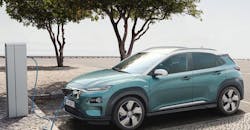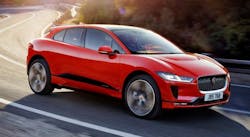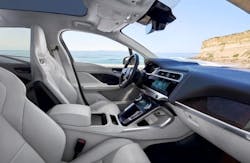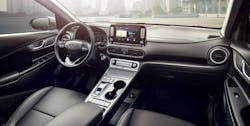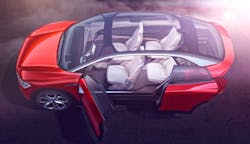Electric SUVs Are Coming to a Showroom Near You …. Soon?
Recently announced, the Jaguar I-PACE is a five-seat electric SUV providing high performance and a unique balance of ride, refinement, and control (Fig. 1). On a single charge, the I-PACE delivers a range of 480 km (WLTP cycle). As defined by EU law, the Worldwide Harmonised Light Vehicle Test Procedure (WLTP) is used to measure fuel consumption and CO2 emissions from passenger cars, as well as their pollutant emissions.
1. On a single charge, the Jaguar I-PACE delivers a range of 480 km.
Power is supplied by state-of-the-art 90-kWh lithium-ion battery comprising 432 pouch cells that were chosen for their high energy density and superior thermal management. Owners will be able to achieve an 80% battery charge from empty in just 40 minutes using dc rapid charging (100 kW), or top up an additional 100 km in as little as 15 minutes. Alternatively, home charging with an ac wall box (7kW) will take the I-PACE from empty to 80% in just over 10 hours, making it ideal for overnight charging.
Jaguar placed the battery as low as possible between the axles, providing 50:50 weight distribution and a low center of gravity, optimizing composure and reducing body roll. These inherent advantages are allied to a light, stiff aluminum EV architecture that delivers torsional rigidity of 36 kNm/degree.
A suite of smart range-optimizing features and smartphone apps will allow I-PACE drivers to monitor vehicle charging from home or confirming available range mid-journey. For example, owners can automatically pre-condition the battery temperature to maximize range, and heat or cool the cabin before starting a journey.
I-PACE performs properly at temperatures as low as −40°C—that’s 10°C lower than conventional EVs. The low resistance of the pouch cells, the battery pack’s insulation, and an advanced thermal management system work in harmony to ensure it works under all conditions.
In moderate temperatures, the battery uses a cooler to maximize energy efficiency. A refrigeration unit linked to the vehicle’s main air-conditioning system activates only at higher temperatures to control cell temperatures and maximize the available power.
A suite of smart range-optimizing technologies includes a battery pre-conditioning system: When plugged in, the I-PACE will automatically raise (or lower) the temperature of its battery to maximize range ahead of driving away.
In cold conditions, a heat pump helps to maintain optimum operating conditions for the cells and the interior. This is more efficient than conventional heaters because it uses energy from outside and heat scavenged from the inverters and power electronics to heat the cabin, rather than relying solely on energy from the battery. Thus, range can increase by almost 50 km—even in freezing winter conditions.
Two Jaguar-designed synchronous permanent-magnet electric motors drive the front and rear axles. Each motor fits concentrically around a compact, single-speed epicyclic transmission and differential, enabling instant and precise distribution of torque to all four wheels as the I-PACE continuously adapts its front-rear balance to suit road conditions. For compactness, drive shafts that pass through the motors themselves are placed at each axle, producing combined performance of 400 PS and 696 Nm, and all-wheel-drive, all-surface traction. The high torque density and high-energy efficiency characteristics of the motors deliver sports car performance, launching the I-PACE from a standing start to 100 km/h in just 4.8 seconds.
A conventional brake vacuum servo has been replaced with an electric brake booster on the I-PACE. This gives the brake system more flexibility when blending regenerative and traditional mechanical braking, providing consistent and precise pedal feel in all circumstances.
The driver can select either high or low levels of regenerative braking to maximize efficiency and optimize vehicle range. When high regenerative mode is selected, it effectively allows the driver to experience intuitive single-pedal driving as the car decelerates when lifting off the accelerator, reducing reliance on the brake pedal when slowing down. It can achieve a maximum regenerative braking force of 0.4 G.
In heavy traffic, the driver can turn off the vehicle’s creep to improve comfort. The driver can also slow the vehicle just by easing off the accelerator pedal with no need to use the brakes to hold the car stationary, even on an incline.
2. Inside the driver’s compartment of the Jaguar I-PACE.
A new human-machine interface (HMI) features two touchscreens on the center console, designed to minimize driver distraction by separating information and interactive controls logically. Rotary controllers provide an essential physical connection between car and driver (Fig. 2).
The full-color head-up display (HUD) projects key information, such as vehicle speed and navigation instructions, onto the windshield to enable the driver to keep their eyes on the road. This is supported by a 12-inch Interactive Driver Display behind the steering wheel, which provides enhanced clarity and flexibility.
An advanced navigation system can sync with a multi-mode smartphone travel app, making it easy for drivers to plan journeys that include driving, walking and public transport. This is supported by Arrival Mode, which can suggest the nearest available parking space in networked car parks or direct the driver to the closest charging point at the end of a journey.
By using the key fob and smartphone Bluetooth signal to recognize an approaching driver, the I-PACE will learn its driver’s preferences and ensure usual climate control, infotainment, and seat settings are ready every time he or she gets behind the wheel.
Over time, algorithms will offer driver-tailored choices based on the time, location, weather and behavior patterns—for example, it could pre-heat the steering wheel and seats for a particular journey.
This will be the first Jaguar able to receive wireless software updates. This ensures that it continuously improves after car delivery, by providing drivers with updates to their infotainment system, telematics unit, and battery charging capability, which reduces the need to visit the dealer for updates.
Hyundai Kona Electric
With the launch of the Kona Electric, Hyundai Motors is offering the a fully-electric subcompact SUV. The Kona Electric enables people to combine the two fastest growing automotive trends: electrification and SUV style (Fig. 3).
3. Hyundai’s Kona Electric is a completely new platform with space-saving integration of the battery packs.
The Kona Electric features two different powertrain versions. The long-range battery version provides driving range of up to 470 kilometers (based on internal targets under WLTP regulations), delivering a maximum output of 204 PS (150 kW). With a battery capacity of 39.2 kWh, the basic version drives up to 300 km on a single charge with the motor delivering 135 PS (99 kW). It also maintains 395 Nm of immediate torque and an acceleration of 7.6 seconds from 0 to 100 km/h.
The car offers pure e-mobility with two different powertrains. The long-range version with the 64-kWh battery provides an electric range of up to 470 km and an energy consumption of 15.2 kWh/100 km (internal target under WLTP regulations). The electric motor delivers an output of 150 kW, accelerating the Kona Electric to 100 kph in 7.6 seconds. Both powertrain versions deliver 395 Nm of immediate torque, having the full power available from the first second, providing a maximum speed of 167 km/h.
Hyundai uses a lithium-ion polymer battery pack for the Kona Electric, which provides excellent charge and discharge efficiency, along with outstanding maximum output. Charging the lithium-ion polymer battery up to 80% only takes about 54 minutes using a 100-kW direct current (dc) fast charger. With the 7.2-kW on-board-charger, charging with alternating current (ac) takes 9 hours 40 minutes for the long-range battery pack and 6 hours 10 minutes for the shorter-range battery pack. Drivers also have the option of charging their car at a compatible regular household power socket using the ICCB-cable (in-cable control box). The charging port is located in the vehicle’s front.
A special feature of the Kona Electric is the shift-by-wire operation module that enables an intuitive operation of the electric powertrain. The adjustable regenerative braking system allows the driver to adjust the intensity of the regenerative braking by using the paddle shifts behind the steering wheel. The system recuperates additional energy when possible. Drivers also benefit from the large 7-in. supervision cluster, which displays key information about the car’s driving performance. In addition, the combiner HUD shows relevant driving information directly to the driver’s line of sight. This fully-electric subcompact SUV also features an electronic parking brake (EPB) at the command of the driver’s fingertips.
The car offers a wide range of connectivity features. For instance, the infotainment system integrates navigation, media, and connectivity features, e.g. Apple CarPlay and Android Auto, as well as wireless charging.
The design theme of the front is picked up at the rear with the rear bumper and a lamp bezel on the slim LED rear lights. Wrap-around claddings with integrated indicator and reversing lights additionally emphasize its progressive design. The rear spoiler features an integrated LED brake light with a width of 1,800 mm and low stance of 1,570 mm.
4. Instrument background color and gauges of the Kona Electric are adapted to always provide the most important and useful information.
The new high-resolution 7-in. supervision cluster displays the different gauges, such as the speedometer, battery charge level, energy flow, and driving mode to the driver. Depending on the selected drive mode, background color and gauges are adapted to always provide the most important and useful information (Fig. 4).
The combiner HUD projects the relevant driving information directly to the driver’s line of sight. This allows faster processing of information while keeping attention on the road ahead. With a projected image size of eight inches at two meters distance and a luminance of more than 10,000 candela per square meter, the new HUD guarantees optimal visibility in different light conditions. The angle and height of the HUD can be adjusted to ensure ideal visibility for individual needs.
Once activated via the button beside the steering wheel, the combiner deploys vertically and disappears into the dashboard when not in use. While driving, the HUD supports safe driving by displaying information, such as speed, navigation commands, and the fuel level, as well as safety-related warnings. Information about the audio mode and radio are projected as well. The table lists the safety-related features of the Kona Electric.
To ensure that occupants’ phones are always charged, the vehicle also provides a wireless inductive charging pad (Qi standard) for mobile phones. The phone’s charging status is visualized with a small indicator lamp above. To ensure that the phone will not be forgotten inside the car, the central display in the instrument cluster shows a reminder when switching off the car.
VW Electric SUV
5. VW’ introduced the I.D. CROZZ electric SUV concept at the 2017 Frankfort auto show.
VW unveiled its electric SUV concept car at the 2017 Frankfurt auto show, but it won’t be available in the U.S. until 2020. Called the I.D. CROZZ, the zero-emission vehicle features the electric 4MOTION all-wheel drive system (Fig. 5). One electric motor works at the front axle and one at the rear; their total output is the equivalent of 302 hp. The driving range of the SUV is up to 500 km on a single battery charge, and boasts a top speed of 180 km/h. The vehicle employs a 83-kWh lithium-ion battery pack. You can charge the battery to 80% of its energy capacity in 30 minutes using a fast-charging system.
About the Author

Sam Davis
Sam Davis was the editor-in-chief of Power Electronics Technology magazine and website that is now part of Electronic Design. He has 18 years experience in electronic engineering design and management, six years in public relations and 25 years as a trade press editor. He holds a BSEE from Case-Western Reserve University, and did graduate work at the same school and UCLA. Sam was the editor for PCIM, the predecessor to Power Electronics Technology, from 1984 to 2004. His engineering experience includes circuit and system design for Litton Systems, Bunker-Ramo, Rocketdyne, and Clevite Corporation.. Design tasks included analog circuits, display systems, power supplies, underwater ordnance systems, and test systems. He also served as a program manager for a Litton Systems Navy program.
Sam is the author of Computer Data Displays, a book published by Prentice-Hall in the U.S. and Japan in 1969. He is also a recipient of the Jesse Neal Award for trade press editorial excellence, and has one patent for naval ship construction that simplifies electronic system integration.
You can also check out his Power Electronics blog.
